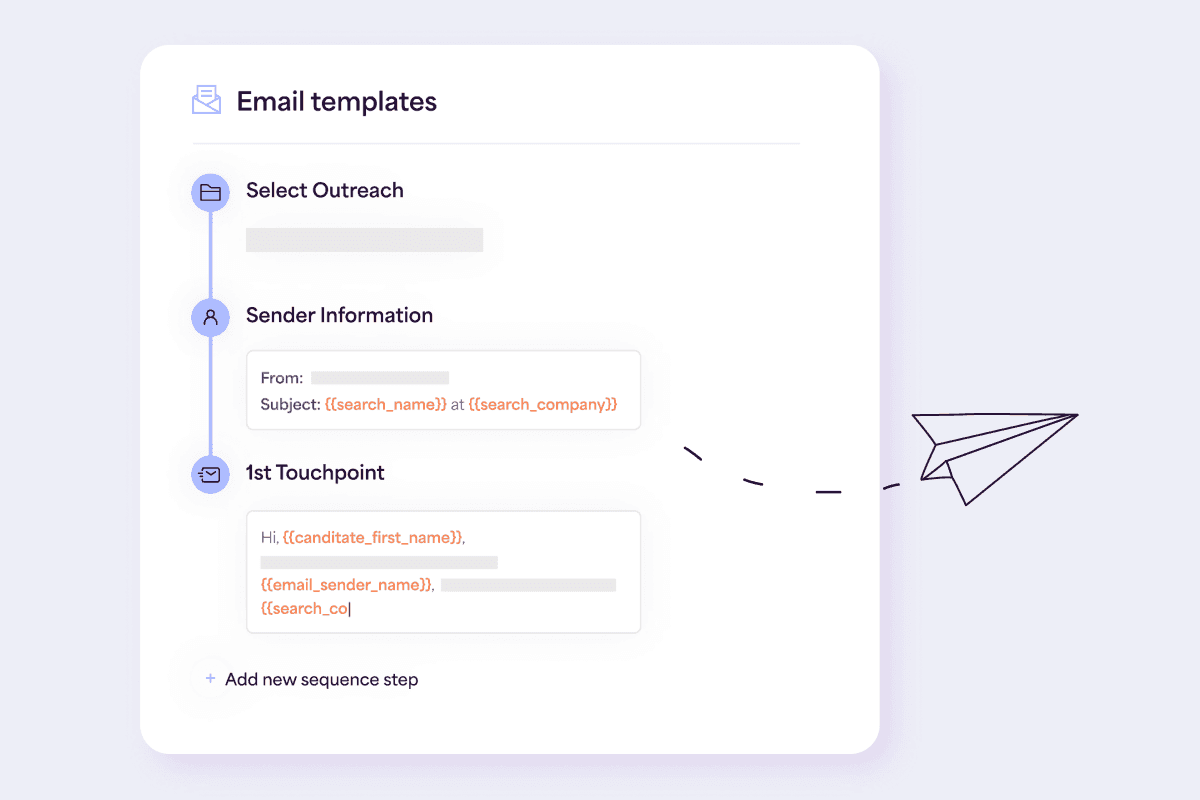How we define the candidate experience
The candidate experience is what a candidate goes through at every stage of the recruiting process, including interactions with recruiters and interviewers. It encompasses how a candidate feels they’re being treated by their potential future employer and how they perceive a company during each step of the hiring process.
Why the candidate experience is more important than ever
A positive, streamlined candidate experience is more important than ever. Because of intense competition for talent, it’s not uncommon for top talent to have multiple job offers – which means they have an upper hand in the hiring process. The hiring experience with you gives a candidate insight into what it will be like to work at your organization as an employee.
However, there’s a drastic difference between employer and candidate perceptions of their hiring journeys overall. 78% of employers think they succeed at setting expectations for and communicating with candidates, while only 46% of candidates agree. This means companies have a ton of potential for improvement!
By investing in a stellar candidate experience, you’re investing in hiring candidates who will move your company forward. Your reputation as a company is tied to your reputation as a potential employer. Impressing candidates will boost your brand’s reputation through word of mouth, and through positive reviews on sites like Glassdoor and Indeed, where candidates will go to ensure a potential employer is in good standing.
A great candidate experience isn’t just good for hiring, though; it also impacts the bottom line. In fact, 65% of candidates said they would be less likely to buy from a business if they were ghosted by recruiters or hiring managers. Especially among younger generations, people want to align themselves with companies that reflect their personal values, both in terms of where they work and who they buy from. Communicating your business’s mission and values in an authentic way during the hiring process conveys that you care about the people that company interacts with.

The most common challenges with the candidate experience
It sounds obvious, but many employers forget that the candidate experience revolves around the candidate. They focus on internal processes and the stress around finding a new hire, and forget to consider the challenges that job seekers face. Job hunting is a fulltime job in itself, which leaves little free time for candidates who are looking for new roles while still employed at their current workplace. Job seekers who are out of work obviously have the pressure of financial strain and uncertainty.
As a company, you can flip the script and actually make the job hunt and getting hired enjoyable for candidates, with the right people and processes in place. Below, we’ve outlined common mistakes to avoid when building out your candidate experience.
Lack of awareness
Understanding today’s hiring landscape and candidate mindset is key. Continuing to pretend that a candidate is only being recruited by your company won’t give you an edge over others hiring in your space. As mentioned earlier, most employers think their candidates have positive experiences…but clearly, candidates don’t feel the same way. If you start by gathering feedback from current candidates on your hiring processes, you’ll get a better picture of the reality and you may get specific ideas on how the hiring experience could be improved.
The heavy workload on recruiters
Today’s recruiters manage the expectations for multiple groups of people: candidates, hiring managers, and other company stakeholders. If your recruiters are spending hours on repetitive tasks like sourcing and reviewing applications, the time they have for individually working with candidates will be limited. This leads to slower response times, and a lack of consistency in communication – which is the opposite of what candidates want! 3
Moving too slow
You won’t be the only company candidates are applying to or interviewing with. If you don’t act with urgency, you will lose top talent to companies that hire faster. While it varies slightly by region, the average hiring process in the U.S. now takes about 41 days. Consider this while establishing your interview schedule. According to CNBC, 70% of job seekers will lose interest in a role if they don’t hear back by seven days after an interview. Keeping candidates engaged is key to making them feel that they (and the open role they’re being considered for) are important to your company.
Lack of personalization
Candidates want to feel like there is a compelling reason to apply for or show interest in a job. When sourcing candidates, aim to inspire them to apply rather than just asking them to. Generic job descriptions, outreach emails, and interview questions won’t excite candidates. In outreach emails, use the candidate’s name and why they specifically need to consider the open role.
Making the candidate jump through hoops
Nothing puts off job seekers like a tedious application and interview process. They don’t have the time (or the desire) to go through an overly complicated and overwhelming application. One common example is asking candidates to manually enter their job history in an application form, even though they’ve already submitted a resume with the same information. Show your candidates you value their time and energy with a streamlined process.
Bias in the hiring process
Bias can be really tricky to spot which is why learning about types of bias and how they can affect hiring decisions is so important. Once you’re aware of biases, take actionable steps to make sure to ensure a more equitable experience for candidates.
Not gathering the data and feedback necessary to improve
As you assess candidates, candidates are also assessing the job opportunity and hiring process. Gathering their feedback is an instrumental piece of improving the candidate experience. A good candidate will ask for feedback after an interview and so should you! Consider creating an anonymous survey for candidates after the interview process so that they feel comfortable being candid.

What candidates want during the hiring process
All of us have undoubtedly experienced the stress and uncertainty of applying, interviewing, and waiting to hear back from a potential employer. It can be nerve-wracking! Put yourself in candidates’ shoes and consider how you’d want to be treated as a potential hire.
Less repetition and friction
If a candidate is excited about a position, keep them engaged and moving along through the process with meaningful, clear steps. Share the goal for each phase, so they understand why they are being asked to meet with a certain person, or do a certain task related to the role.
Clear communication and transparency
Recruiters are responsible for keeping candidates informed about the hiring process. Make sure candidates know what to expect from interviews and when they will be hearing back from you on the next steps. When a candidate reaches out to you, respond promptly. Even if you can’t answer their question right away, acknowledge their message and let them know you’re working on it.
Follow-up and honest feedback, even if they aren’t moved to the next stage
Ghosting is extremely frustrating for job seekers, especially after they’ve made it to the second or third round of interviews. Candidates put time and energy into preparing for interviews and it’s respectful to let them know why they are or aren’t moving on to the next round. A candidate who gets passed on for one role could be a good fit for another role later, so keep them in your pipeline.
Feeling respected and that their time is valuable
Understand that candidates are learning about you and interviewing you as much as you are interviewing them. If candidates don’t feel valued throughout the hiring process, they’ll take that as an indicator of what it will be like to actually work at your organization. If they don’t feel respected as a candidate, they’re less likely to accept a job offer because they’ll assume they won’t be respected as an employee.

How to improve the candidate experience at every stage
There are many steps in the hiring process. Take a look at each one through the eyes of the candidate, in order to create a better experience for them. There’s a lot that can be done, but you don’t have to change everything all at once. Small improvements can have a big impact, and gathering feedback along the way will help you decide which changes to prioritize.
Employer Branding
Your brand is a candidate’s first impression of your company. Today, recruiters need to think like marketers and leverage their brands in order to attract candidates.
Website
Your website is the first place candidates will go for information about your organization. Highlight your culture and values prominently. Include pictures of your team, Employee Resource Groups available, and any other creative perks you offer. Make sure your career page is easy to find and navigate so you don’t miss out on great candidates because they aren’t sure where to learn more about you.
Social
Social media platforms are an essential recruitment marketing tool: 96% of active job seekers are on social media and 49% follow companies to stay up to date on job openings. With a strong social media presence, you have the potential to win over candidates by telling a story about your company’s culture and people.
For example, create a hashtag to use on social that highlights your company culture (i.e. #LifeAtAcme). Celebrating employees’ successes on social media adds a layer of authenticity and is also a great way to showcase your supportive culture. Promoting your job openings on social channels also makes it easy for your internal teams and followers to share posts with others in their network who may be a good fit. It’s a great way to build awareness, and build your employer brand.
""On average, we have 30% higher accessibility to quality talent after using employer branding. It’s a proven fact that top talent isn’t after money — they’re after a peaceful work environment where enough freedom is provided. Employer branding was our chance to show that we offer the same.”
- Caroline Lee, Co-founder, CocoSign
Job Descriptions
In job postings, be clear on what you are looking for in a new hire. Give candidates the information they care about: expectations for knowledge and skills, who they’ll work with, and essential functions.
Focus on impact
Beyond the role’s responsibilities, describe how the job will impact the organization's larger mission. Let candidates know they won’t just be a cog in the system but a meaningful asset to the company’s growth.
Prioritize accuracy
Work closely with hiring managers to make sure descriptions are accurate. You don’t want to prescreen a lot of candidates and then find out they aren’t the right fit because the job description was missing a key point. It creates more work for you as a recruiter and wastes the candidates’ time.
Write inclusive job descriptions
From where you post your job listings to the words you use, small factors can make a huge difference in who sees your postings and who feels comfortable applying.
Make job descriptions unique
After writing a job description, ask yourself if it could apply to any company, or if it’s specific to your company and its goals. Even a job description can tell a story; what is the story for this particular role, and where does it fit into the big-picture story for your company?
Include information on benefits
Some candidates may not feel comfortable asking about benefits in the early stages of the interview but don’t want to potentially be disappointed later on with benefits that don’t work for them or their families. Listing your organization's benefits in the job description will not only help to increase interest, it will put candidates at ease and help you weed out those who would likely pass on the offer down the road.
The application process
60% of job seekers quit applications before finishing because of length and complexity. That means this is one area of the candidate experience that often needs to be reconsidered.
Be clear
Include straightforward instructions on the information and materials the candidate will need to complete the application.
Save candidates’ time
Only ask for essential information that can’t be found on their resume.
Save yourself time
Use tools to pre-screen resumes so you can get back to applicants faster.
Stay current
Make applications mobile-friendly. You’ll also want to consider how friendly your application process is to someone with accessibility limitations.
Test it out
Try going through your own application process as if you were a recruiter. Time yourself to get a realistic sense of how long it takes and if there are areas that could be streamlined.
Outreach
Getting your emails to stand out in candidates’ inboxes takes effort. Develop outreach and nurture campaigns that are unique to your company and highlight more than just the role’s responsibilities. Personalization is key, both in the subject line and body of the email.

Reach out to passive candidates
Just because a person is currently employed doesn’t mean they aren’t the perfect candidate. 87% of the total workforce (both active and passive candidates) is open to switching jobs. However, passive candidates won’t respond to any old recruiting email. From your subject line to your Call to Action, make sure your emails are unique, personalized, and showcase your company’s brand. Spark interest in highlighting the key points about the role, without overwhelming them with too much detail.
Reach out to active candidates
Active candidates’ first point of touchpoint may be via a job posting or application. To move them through the hiring process, you’ll still need to create outreach campaigns that keep candidates interested in the role. As with passive candidates, make sure your messaging to active candidates is personalized and representative of your company’s culture.
Interviews
Interviewing is the first step in companies getting to know candidates in-depth, and for candidates to get a feel of the company they could potentially work for. Improve your interview process with the following best practices.
Be candid
Explain the steps of the interview process upfront so the candidate knows what to expect and prepare. Make sure each step is necessary and has a goal; for example, your head of sales interviewing product manager candidates, to talk about go-to-market strategies.
Stay organized
Create a schedule and stick to it (and share it with the candidate!) If there are long gaps between interviews, your candidate will lose interest or get scooped up by a competitor.
Eliminate bias
Reduce bias in the interview process by understanding and training your team on how bias can sneak into interviews.
Use inclusive language
Avoid gendered language like “guys” and “moms and dads.” Consider including your pronouns in your email signature so that candidates are comfortable sharing their own.
Make scheduling easy and flexible
Avoid the string of back-and-forth scheduling emails by providing a calendar link for candidates to book at times they’re available.
Standardize
Use the same questions for each candidate. However, they should vary at different stages of the interview process, so that the candidate isn’t answering the same questions again and again.
94% of talent wants to receive interview feedback, but only 41% have received interview feedback before.
- via LinkedIn
Evaluate with a diverse decision-making team
If you can, try to include people from different backgrounds and teams in the interview process so that a candidate gets a wider range of perspectives.
Understand that flexibility is necessary within reason
This is especially important for parents who may need to reschedule or show up a little late because they’re caring for kids or other loved ones. If a candidate asks to reschedule too many times, that’s a red flag. However, allowing for some flexibility demonstrates that your organization is realistic and understanding. This includes accepting that family or pets may make an appearance on virtual interviews!
Offer interview feedback
When candidates are passed on with no explanation, they’re left in the dark wondering what they did wrong. Letting them know where they excelled and how they could improve will help them prepare for their next interview.
Don’t stray from what’s important
Only ask questions that are relevant to why the candidate is right for the job. A candidate may not be comfortable sharing details about their lives outside of work. For example, asking if a candidate is in a relationship or has kids may be a sensitive subject for them and isn’t indicative of their abilities. Plus, candidates might also perceive this as an employer trying to gauge what their time commitment will be to work.
Stay focused on the candidate
Demonstrate that you value each prospect and their time by giving them your full attention. Turn off email and messaging notifications. By staying present, you’ll also get to know the candidate better and provide a more engaging experience overall.
Job offer
A candidate’s experience doesn’t end once you’ve decided who to hire. How you offer candidates job opportunities is also a fundamental part of the candidate experience.
Move quickly
While it’s important not to rush the decision-making process, make a job offer as soon as you’ve decided on a candidate. You don’t want to leave the candidate wondering about where they stand, especially if they’re your top choice!
Celebrate the candidate’s win!
Always call candidates to express your excitement and congratulate them. Let them know that you are looking forward to working with them and make them feel welcome right off the bat. If you are an external recruiter, give them a call to let them know it was great to work with them, to increase your chances of working with them in the future.
Share why they are the right choice
Let your new hire know they were the best fit for the job. Not only will this make them feel good, but it will also give them insight into which of their qualities will help them succeed in the role.
Show them the money
Include clear compensation information in your job offer. You can add more transparency by demonstrating how you got to this number and how this compares to the industry’s average. Go over what benefits your organization offers and invite them to ask any questions.
Establish a timeline
Let a candidate know when you’d like to hear back on their decision. Employers usually ask for a decision within one week to give candidates time to consider making the jump. During that week, remember to keep in touch with your other top choices and let them know about your timeline too, so they don’t feel left in the dark
Create a welcome committee
Ask employees that will be working closely with new hires to reach out, welcome them to the team, and offer support for getting the new hire settled.
Give them a welcome gift
Once they’ve accepted the offer, send them swag to get them excited about starting and make them feel like part of the team.
Ask for feedback
Survey candidates and ask them to rate their satisfaction level at each stage of the process. Include open-ended questions so that they can provide qualitative feedback and suggestions, in addition to quantitative data,
Onboarding New Hires
The next step in the process is onboarding. There’s a lot that goes into a successful onboarding process, but the bottom line is that your hiring process should flow seamlessly into onboarding.
Give a welcome tour
Whether virtually or in person, welcome new hires face-to-face and give them an “office” tour. If your company is working remotely, you can still show them which tools they’ll be using, how to find shared drives, and how their team likes to communicate.
Set a meeting with HR ASAP
New hires should meet with HR on their first day to review how to enroll for benefits, go over company policies, and let new hires know that HR will support them should any issues arise.
Gather data at every step of the process
You can’t improve your candidate experience without gathering the right information.
Gain insight from current employees
Feedback from current employees is incredibly valuable because they’ve experienced your company’s hiring process already. They can tell you what they liked and what they didn’t. They will also be more comfortable sharing critiques because they won’t be worried about not being hired based on their feedback.
Collect more data points
You’ll increase your opportunities to collect data by 550X if you get feedback from candidates after every step of the process rather than waiting until the very end. In the next section, we’ll cover what you can track at each step of the hiring journey.

Measuring the candidate experience in a meaningful way
Using both quantitative and qualitative metrics throughout the hiring process allows you to gain a full understanding of how your candidate experience is received. Metrics are critical because you can’t create a great experience unless you know what candidates actually think. Constant monitoring and check-ins on these metrics will lead to continuous improvement and better hiring results.
Track completed applications from job postings
Whether through your career page or an external channel, gauging how many candidates choose to apply once seeing the job posting is a critical metric to measure. If most candidates are applying through external sites rather than from your career page, check to see if your career page is easy to find on your website or difficult to navigate. If application rates are generally low, take another look at your job descriptions to see if they could be more inclusive, or more clear.
Analyze applications started vs. completed
When too many candidates start but do not complete applications, this is a sign that your application process is too long or complicated. Consider how you can simplify the process to encourage more candidates to complete applications.
Gauge outreach efforts
Keep track of open rates (emails opened / number of emails delivered), response rates (number of replies / number of emails delivered), interested rates (how many candidates express initial interest in a role), and conversion rates (number of candidates interviewed). If any of these ratios are low, take time to make adjustments to your strategy. Wondering how your outreach efforts stack up?
Check out the below averages pulled from Fetcher data.

Understand the timing of your pipeline
Track the time it takes to move candidates through every stage of the hiring process so you can identify bottlenecks. If your hiring process is too slow, candidates will be frustrated and lose interest.
Collect feedback at every stage of the hiring process
To reiterate, gathering direct and immediate feedback from candidates and new hires will give you the most insight into where you need to improve and provide the most details. Consider using survey tools or a third-party research company to develop and distribute an objective survey.
Make adjustments based on results
It’s not enough to just collect these data points. Learn where you stand and make the necessary adjustments to stay ahead of the competition with superior candidate experience.

How Tech is Improving the Candidate Experience
A quick hiring process leads to open roles being filled faster, a decrease in cost-per-hire, and ultimately, happier candidates and recruiters. On the flip side, the more hurdles companies have throughout their pipeline, the more likely they’ll lose top candidates as they grow impatient. In today’s market, companies need to take advantage of tech that allows them to scale and move quickly if they want to secure their top candidates.
How Candidates Feel About Technology in the Hiring Process
Candidates recognize that tech speeds up a lot of manual processes that would otherwise hold up a recruiter from reaching out to them sooner. Plus, tech provides more ways for the candidate to stay in touch with potential employers throughout the process.
How candidates feel about tech in the hiring process

From the employer’s perspective, tech is empowering recruiters to focus on the human parts of their job, and spend less time on repetitive tasks. Consider that the average recruiter has 30 to 40 open requisitions for open roles they need to fill. Tech tools and automation are allowing recruiters to offer a high touchpoint experience for candidates, without necessarily having to manually deliver each of those touchpoints themselves. Email automation, automated resume screening, and chatbots can help speed up and bring consistency to the hiring process, which is important to candidates and important for your brand. Technology will also help fill positions faster, which benefits both candidates and your organization.
"Because we use automation, our People Team has more time to engage with candidates, help to promote the Fetcher brand, and gauge overall performance so that we can continue to grow."
- Andreina Naim, Head of People, Fetcher
Especially in today’s market, companies need to prioritize the candidate experience. Whether your organization is making 100 hires this year or one, the experience you create for candidates will determine whether you reach your hiring goals. A better candidate experience indicates that your organization not only values its current team members, but its potential team as well. By impressing current candidates, you’ll increase brand awareness, and boost your organization’s reputation – which will, in turn, lead to more and better candidates in the future.
Fetcher enables recruiters to source candidates faster and automates and personalizes their outreach and nurture campaigns. Our humans in the loop ensure that only candidates that meet your specific criteria land in your inbox. Recruiters spend an average of 13 hours a week on sourcing alone. Fetcher gives you that time back! With that extra time, recruiters and TA teams can engage with candidates and hiring managers, respond to candidates faster, and support them through the interview process.




